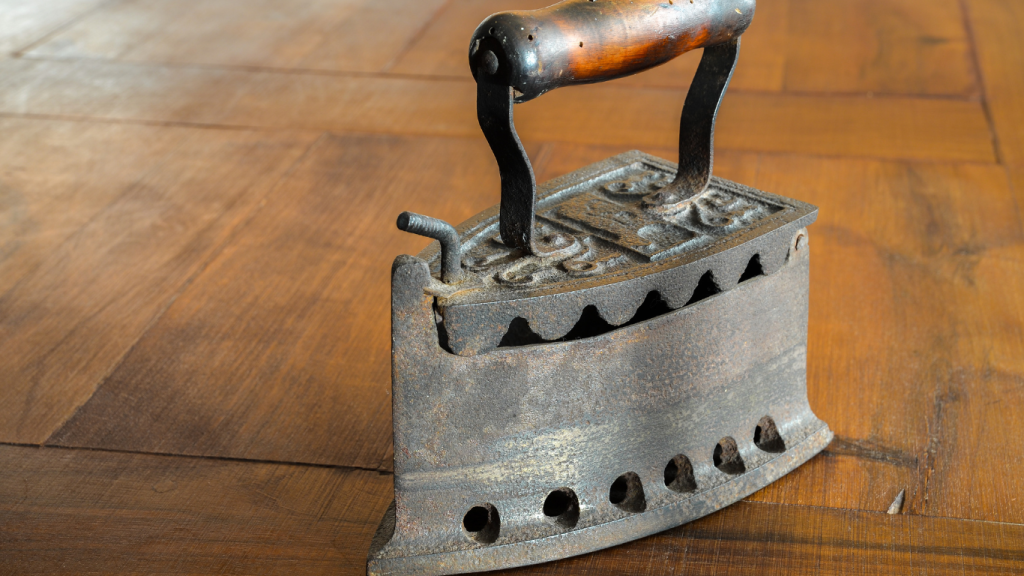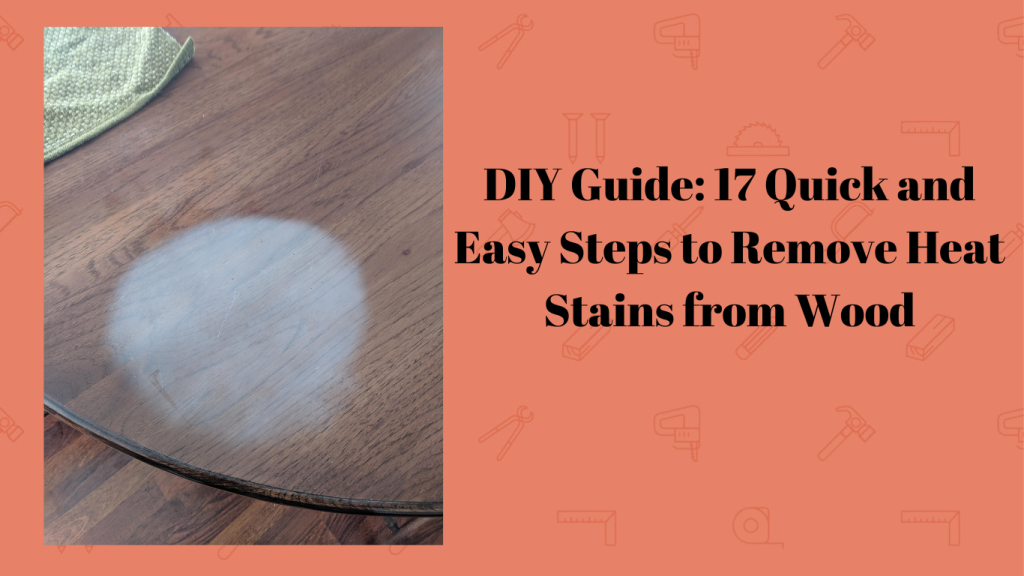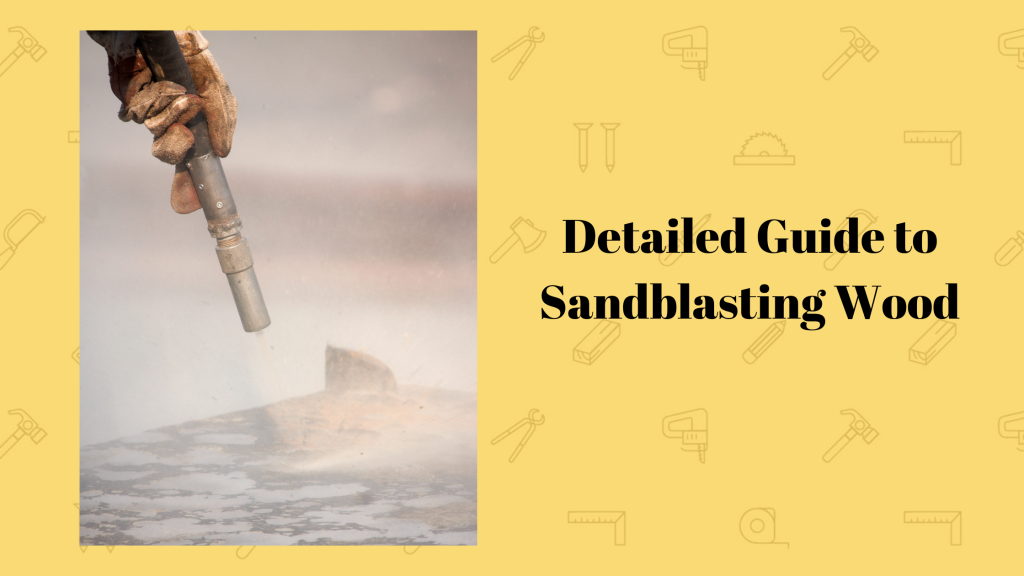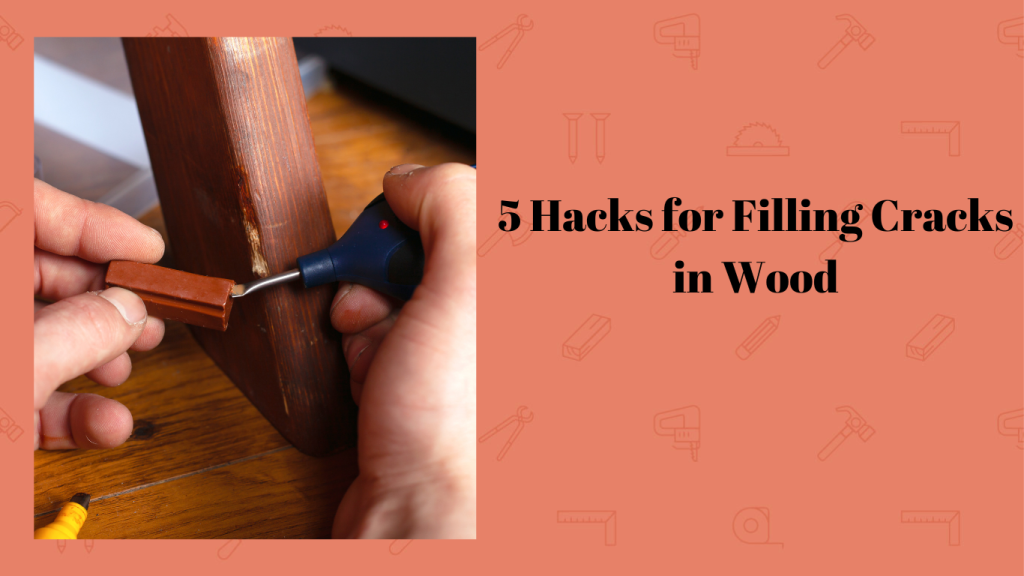Knowing how to remove heat stains from wood is an essential woodworking skill. Everything about heat stains on wood is ghetto – from the trapped moisture underneath to the marks on the surface. It’s enough to change a grown man’s mood (not like I’ll know or anything).
Anyways, if you collect woodwork, removing heat stains is a part of the orientation process. Like filling screw holes in wood, this skill will help you restore your woodwork without calling maintenance. You save money and revive your precious woodwork – it’s a win-win.
Read on as we explore how to remove heat stains from wood, different working techniques, and how you can wage war against heat stains in the future.
The Science of What Causes Heat Stains
Heat stains form in the trickiest of ways. You could’ve placed a hot kettle on top of the wooden surface or even a tray of oven-fresh cookies. When the heat comes in contact with wood, the wood expands and sucks in moisture.
Now moisture is in the wood, but not after leaving annoying white heat rings on the wood’s surface. After you remove the hot object, the wood cools down and contracts, further sealing in the moisture.
In my experience, my walnut table was sealed, so you imagine my surprise when I learned that sealing wood doesn’t make it immune to heat stains. No one is safe, my friend.

17 Different Ways to Remove Heat Stains from Wood
We now have the tools, so all that’s left is the know-how. Most of the tools are readily available at home, but I’ve some variety just in case.
Here’s how you can conquer heat stains in wood at home by yourself:
Whip Out The Mayo
You’ll need:
- Some mayonnaise
- A cloth rag
Bring out the mayonnaise in the fridge and layer some mayo on the marked surface and let it sit on the entire stain. Don’t use a whole dollop, a thin layer should be enough
In about three hours, wipe off the mayo with your rag cloth, and the previous stain should be as good as new. Petroleum jelly is a good substitution here too!
Oil and Salt Works Too
You’ll need:
- Oil
- Salt
The key ingredient in mayonnaise is the oil. It stimulates the wood’s pores to open, allowing water to escape from the wood. But you can combine vegetable oil with salt for a combo effect.
In a bowl, combine one part of vegetable oil with two parts of salt, and mix till you have a paste. Then use a spoon to scoop on and apply a layer over the heat stain.
As the oil opens the pores, the oil will instantly dry out the moisture. Don’t wipe it off immediately, though. Set a timer for 2 hours and plot while you wait.
Toothpaste
You’ll need:
- Toothpaste
- Baking soda
- A rag
Heat stains and plaque have one thing in common – a fear of toothpaste. Since we all have a tube of home, why not give it a try?
First, you need the most minimalist toothpaste you can find. Think about those white, gel-free ones at the department store. When combined with baking soda, these toothpastes create a powerful paste that can even dissolve wood finish.
To make it, combine one part of toothpaste with two parts of baking soda. Then, spread it across the heat stain, stay close and wipe after 2 minutes. The stain will lift a little after this procedure, but you’ll need to do it a few more times for total removal.

Hear Me Out: More Heat [My go-to to remove heat stains from wood]
You’ll need:
- Hairdryer
Before you call me batshit crazy, I’m not asking you to place another hot skillet on the heat rings. Rather, we’ll be using a blowdryer to expand wood pores and dry the moisture. But there’s a catch – if things go south, you may end up with more heat stains.
Turn on your hairdryer and set it on the lowest setting. Next, float it across the heat stain while holding it at least 5 inches. The hotter the dryer, the farther away you want to hold it.
Vinegar and Oil
You’ll need:
- Vinegar
- Oil
- A small paintbrush
- A bowl
Mold and stains aren’t the only things that yield to vinegar – even heat rings aren’t spared. In a kitchen bowl, mix equal parts of vinegar and oil, and set it down. Then, using the rag, remove any debris from the wood’s surface.
Dip the paintbrush inside the vinegar-oil solution and glaze across the heat stains. Let it sit for an hour before wiping it off with the rag,
Scrub with Steel Wool
You’ll need:
- A cautious hand
- Oil
- Steel wool
Another common method of removing heat stains involves scrubbing with steel wool. Like sandpaper, steel wool has abrasive properties, but it also can do damage without proper control.
Soak the steel wool in oil for 10 minutes. Then, use it to lightly scrub the white heat rings till they disappear
Sanding
You’ll need:
- 180-grit sandpaper
- Conditioner
- Wood stain
As a final resort, consider sanding the marked patch of wood. It is one of the most time-consuming options, but it also has a high success rate.
With your sandpaper, sand down the wood, using the moisture as a guide. Then, prepare the wood for staining by using a high-quality wood conditioner. Then stain the wood as usual.

A Fresh Squeeze of Lemon
You’ll need:
Lemon
Salt
A cloth
Start by rolling a lemon on the counter to get the juices flowing, then cut it in half and squeeze out the juice into a bowl. Add a spoonful of salt to the lemon juice to create a potent, stain-busting paste. Apply this zesty paste to the heat stain on your wood using a cloth, taking care to cover the entire area. Leave it to work its magic for about an hour, then simply wipe it away with a clean cloth. Not only will the stain be gone, but your furniture will smell citrusy fresh!
Say Yes to Ashes
You’ll need:
Cigarette ashes
A damp cloth
Believe it or not, the ash from cigarettes can be a very effective tool for removing heat stains from wood. First, gather enough ashes to cover the stain – make sure to thank any smokers for their contribution to your DIY project! Apply the ashes directly onto the stain using a damp cloth. Lightly rub in circular motions until you see the stain start to disappear. It’s a bizarre method, but you’ll be amazed at the results!
Talcum Powder and Water
You’ll need:
Talcum powder
Water
For this method, you’ll need to create a thick paste with talcum powder and a few drops of water. This paste will be your secret weapon against stubborn heat stains. Apply the paste liberally over the stain and let it sit overnight, soaking in and working away at the stain. Come morning, simply wipe off the dried paste, and you’ll find your wood stain-free and looking wonderful!
Mighty WD-40
You’ll need:
WD-40
Cloth
This handy lubricant is known for fixing squeaky hinges, but it also works wonders on removing heat stains from wood. Simply spray a liberal amount of WD-40 on the stain. You’ll want to make sure the stain is fully covered with the WD-40, so don’t be shy! After a few minutes, wipe the area with a clean cloth, applying a bit of elbow grease. You’ll be pleasantly surprised to see that the stain has disappeared, leaving your wood looking better than ever.

Baking Soda and Water
You’ll need:
Baking soda
Water
Baking soda, a well-known cleaning powerhouse, can tackle even the most stubborn heat stains on wood when paired with water. Mix baking soda and water to form a thick paste – about the consistency of toothpaste. This paste is going to get right into the stain and lift it out. Apply the paste to the stain, ensuring every part of the stain is covered. Leave the paste to dry, which should take a couple of hours. Once dry, gently wipe off the paste and watch as the heat stain disappears right before your eyes!

Iron It Out
You’ll need:
Iron
Thin cloth or towel
Water
Ironing isn’t just for clothes, it can also be used to remove heat stains from wood. Fill your iron with water and set it to steam mode. Place a thin cloth or towel over the stain on your wood furniture. Carefully apply the iron over the cloth, moving it around so as not to overheat one spot. The heat and steam will work together to lift the stain, restoring the natural beauty of your wood.
The Power of Hydrogen Peroxide
You’ll need:
Hydrogen Peroxide
A cloth
Hydrogen Peroxide is known for its bleaching properties which can make it highly effective when trying to remove heat stains from wood. Dab a cloth into some hydrogen peroxide and apply it directly onto the stain. Let it sit for about 30 minutes to an hour. Rinse the area with a damp cloth afterwards and you’ll find your heat stain significantly lightened, if not gone!
Say Cheese: Cream Cheese and Baking Soda
You’ll need:
Cream cheese
Baking soda
Mix cream cheese and baking soda to form a paste. The unique combination of these two household items creates a powerful remedy for heat stains. Apply the paste over the wood stain and let it sit for an hour or two. When time’s up, wipe off the paste and you’ll find your wood looking as good as new!
Boiled Milk and Lemon Juice
You’ll need:
Milk
Lemon
A cloth
Heat a cup of milk until it’s just about to boil, then add in the juice of one lemon. Allow the mixture to cool before applying it to the heat stain with a cloth. The combination of milk proteins and citric acid from the lemon can work wonders on heat stains. Let it sit for an hour, then wipe away with a clean cloth.
The Magic of Petroleum Jelly
You’ll need:
Petroleum jelly
A cloth
When in doubt, grab the petroleum jelly! Apply a generous amount of petroleum jelly to the heat stain and leave it overnight. The jelly will gradually seep into the wood, lifting the stain as it goes. The next morning, wipe away the jelly to reveal your refreshed, stain-free wood.
Prevention is Better than Cure
As rewarding as it is to remove heat stains from wood, it is still very stressful. So, as you fight heat rings on wood, you should know how to prevent them:
Here are a few foolproof ways to prevent white heat rings in your wooden furniture:
- Use a tablecloth to protect the wood against heat from food plates
- Invest in coasters and place them under cups and mugs as you use them
- Since we know that a wood finish isn’t enough, consider covering the table in wax. They do a far better job of protecting the wood.
Frequently Asked Questions
What Causes Heat Stains on Wood?
Heat stains occur when a hot object touches a wooden surface. The heat expands the wood’s pores, causing them to absorb and trap moisture. The result is an annoyed woodwork owner searching for “how to get white heat marks off wood table.”
How Long Does it Take to Remove a Heat Stain from Wood?
The average time it’ll take you to remove a heat stain is an hour. Depending on your chosen fight method, it may be slightly more or less, but the procedures are generally short.
What Tools Do I Need to Remove Heat Stains From Wood?
There are different methods shared by people who know how to remove heat stains from wood. So, depending on your preferred method, you’ll need salt, vegetable oil, mayonnaise, vaseline, or a hairdryer.
How to Fix the Finish of the Wood after Removing a Heat Stain?
In this scenario, the most effective way to fix the wood finish is to sand it down and stain it afresh. Just go in with 180-grit sandpaper until you have a uniform surface. Then dust it off and stain it to match the remaining wood.
Huddle Up
Heat stains are stronger, but after reading this guide, we are stronger. Discovering a heat stain is far easier when you know how to remove heat stains from wood. Plus, almost all the materials you need are sitting in your pantry.
Whichever way you choose, monitor the process carefully and avoid further damaging the wood. See you at dusk – victory over heat stains!
*This post may contain affiliate links. Please see my disclosure to learn more.



